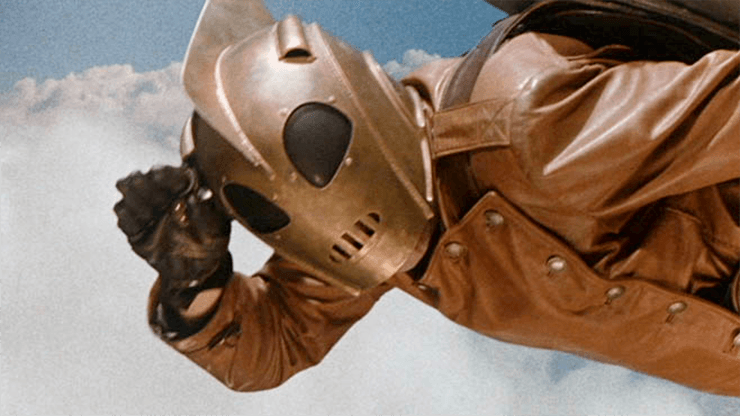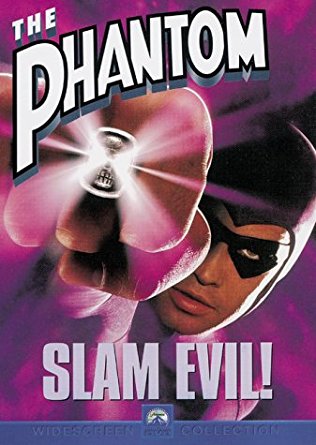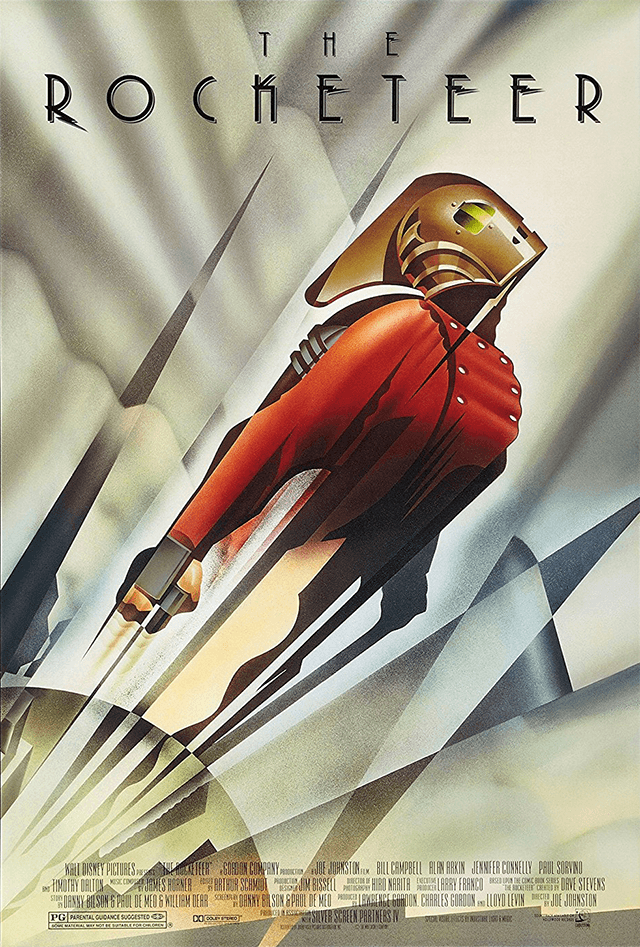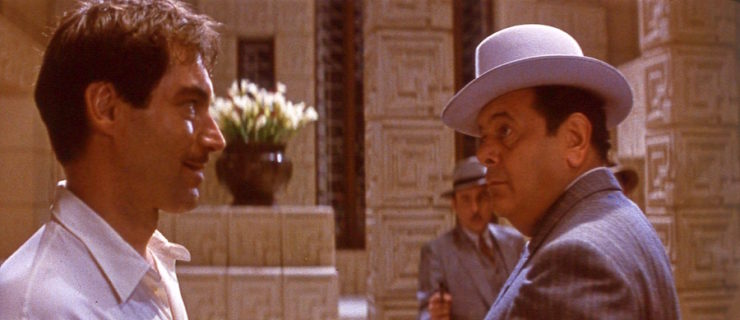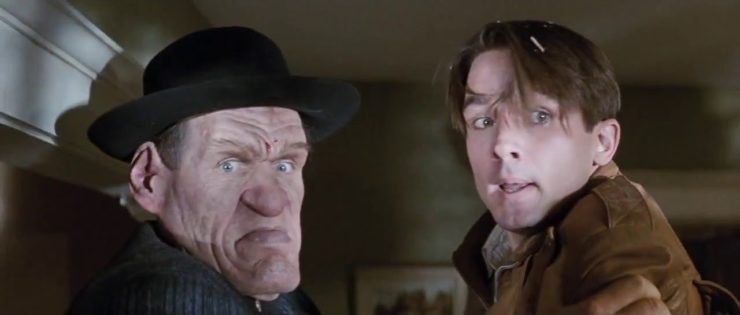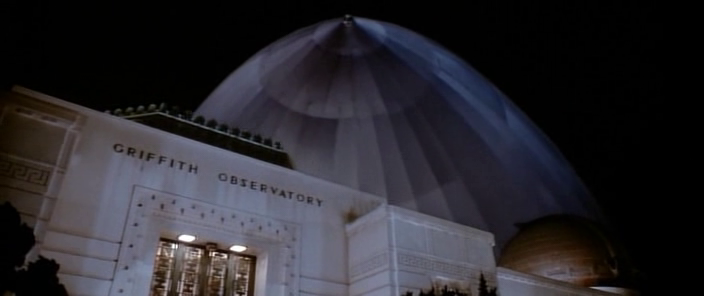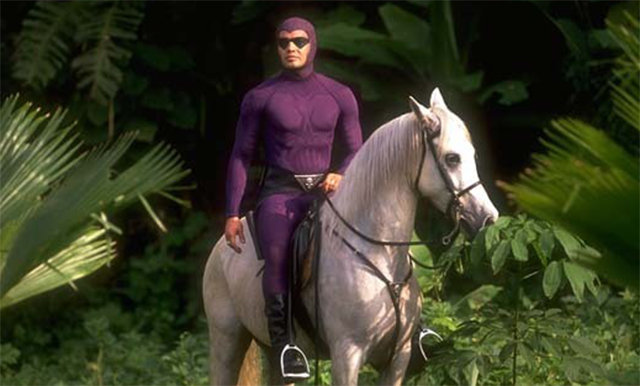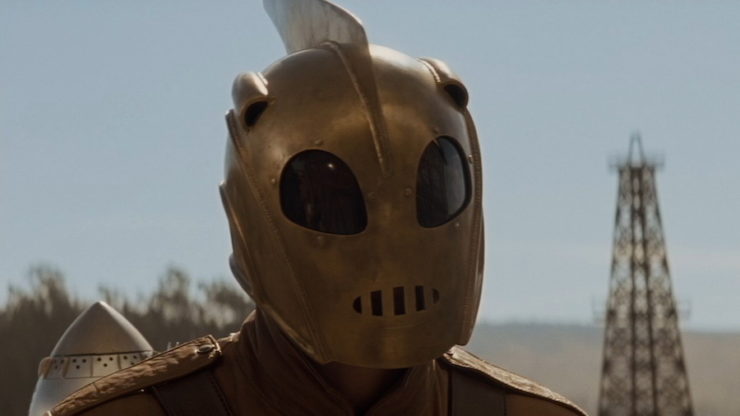The Rocketeer was created in 1982 by the late Dave Stevens as a tribute to Depression-era movie serials and comic strips and such. Stevens had an affinity for the pop culture of the first half of the 20th century, having made a career of creating art in the style of that bygone era. Besides The Rocketeer, his best-known works were his illustrations of pinup model Bettie Page (who was also a supporting character in The Rocketeer).
The Phantom was created in 1936 by the late Lee Falk (who continued to write The Phantom comic strip until his death in 1999 at the age of 87), and was the very type of adventure story that Stevens was nostalgic for and trying to re-create with his Rocketeer character.
Both characters were adapted into live-action movies in the 1990s that took place in 1938 and would prove to be disappointments at the box office.
The Rocketeer film rights were sold by Stevens within a year of the character’s creation to Disney, but it took the better part of a decade for the movie to actually be made. Part of this was due to creative differences, including Disney wanting to change the design of the character’s outfit, and director Joe Johnston wanting to cast a relative unknown in the title role.
Eventually, the movie was released in 1991 with Billy Campbell in what he had hoped to be his breakout in the title role. Co-stars included former James Bond Timothy Dalton as the Errol Flynn-esque Neville Sinclair, Jennifer Connelly as Jenny Blake (a reworking of Page), and Alan Arkin as Peevy. Hopes of sequels (Stevens and screenwriters Danny Bilson and Paul De Meo envisioned this as a trilogy) were dashed by the movie’s poor box office and lukewarm reviews. This remains the only screen version of the Rocketeer, so far, at least—Disney’s been talking about a new Rocketeer movie for more than five years now.
The 1996 film version of The Phantom was one of many screen adaptations of the character, though the only live-action feature film. There was a movie serial in 1943 starring Tom Tyler, two animated series that featured the character (Defenders of the Earth in the 1980s and Phantom 2040 in the 1990s), a TV miniseries starring Ryan Carnes in 2010, and an unsuccessful pilot for a TV show in 1961 starring Roger Creed, Lon Chaney Jr., Paulette Goddard, and Richard Kiel.
Neither of these two films really did well with movie audiences, though both have something of a cult following now. (Johnston credits his directing of The Rocketeer with getting the gig to direct Captain America: The First Avenger.) It is safe to say that The Phantom‘s tag line of “SLAM EVIL!” remains the worst tag line in the entire history of Hollywood…
“I don’t work for no two-bit Nazi!”
The Rocketeer
Written by Danny Bilson & Paul De Meo & William Dear
Directed by Joe Johnston
Produced by Charles Gordon & Lawrence Gordon and Lloyd Levin
Original release date: June 21, 1991
In 1938, stunt pilot Clifford Secord tests his Gee Bee, which has been put together by his crew, led by “Peavy” Peabody. He flies right over a car chase—two feds are chasing a couple of gangsters who stole a personal rocket-pack from inventor Howard Hughes. One of the gangsters shoots at Secord’s plane, thinking that it belongs to the feds, and the Gee Bee is badly damaged and crashes. One gangster is killed, but the driver swaps out the rocket pack for a vacuum cleaner, hiding the rocket in an abandoned plane in a hangar. The car winds up crashing into a fuel tank and exploding, though the driver bailed out before that. Before he’s taken the hospital, the gangster tells the feds that Hughes’s property blew up with the car. The feds recover the wreckage and return it to Hughes. The inventor makes it clear that he will not try to make another rocket pack.
Secord and Peavy are devastated, as the airfield owner, Otis Bigelow, is charging them for the damage, and they’re out a plane. Bigelow talks them into reviving their clown act to pay down the debt, which Secord reluctantly agrees to. As he and Peavy are digging the clown plane out of mothballs, they find Hughes’s rocket pack, which the gangster hid in their plane.
They test it on a statue and discover that it works beautifully, though it needs a helmet for protection and to steer, as there’s no rudder. Peavy writes up specs for the rocket and designs a helmet. Secord wants to use this jet pack as a new flying act that will pay much better than the clown act. Peavy wants to test it further before they try it.
The gangsters who stole the rocket in the first place work for Eddie Valentine. Valentine, in turn, works for Neville Sinclair, an actor who has hired Valentine to retrieve the rocket. Valentine isn’t thrilled that one of his people is dead and that the feds are after him.
Secord takes his girlfriend, Jenny Blake, out on a date to see a movie. The newsreel before the picture talks about a German zeppelin that is flying across country and will arrive in Los Angeles soon. This might be important later.
The movie is a Sinclair picture about aviation, which Secord and his buddies pick apart at the Bull Dog Diner after the movie, to Blake’s annoyance. Blake is in Sinclair’s latest flick, though she didn’t get the part of the princess with one line of dialogue (that went to the producer’s niece, who is terrible), and is instead an extra.
Blake also finds out about Secord almost dying and losing the Gee Bee by accident, as Malcolm, one of the pit crew, mentions it, assuming she already knew. But Secord didn’t want to worry her, and then—because he hasn’t pissed her off enough—he also belittles her acting career. She then storms off in a huff.
Sinclair sends a massive thug named Lothar to question the driver in the hospital, who reveals where he hid it right before Lothar breaks him in two. (The nurse and cop guarding him are too busy listening to the radio to hear him until it’s too late.)
However, Valentine’s goons don’t find the rocket pack where the driver said it would be. They keep an eye on the air show, figuring that one of the pilots who rent space there and perform in the show might have it.
Secord is late to do the clown show, and Malcolm overhears Bigelow threatening his job if he doesn’t make it. Already guilty about spilling the beans to Blake, Malcolm puts on the clown suit and flies the plane. Unfortunately, he hasn’t flown a plane in 25 years, and he loses control of the bird. Secord puts on the rocket pack to enact a rescue, which he does, albeit with a certain amount of property damage. While Bigelow isn’t thrilled with the latter, he loves the attendant publicity, naming this new attraction “the Rocketeer.”
Peavy tracks down Secord where he crash landed, and they get away from what they think is the press, but is actually Valentine and his goons.
Secord goes to the set of Sinclair’s movie to tell Blake about the rocket, but he accidentally knocks over a fake wall before saying he’s there to see Blake. Sinclair angrily has Blake fired for this (it’s supposed to be a closed set), but then he overhears Secord telling Blake about his new find. Blake doesn’t want to hear it, and storms off. Sinclair tracks her down and rescinds his firing of her, and also asks her out to dinner at the South Seas Club (which is owned by Valentine).
Lothar goes to Bigelow to find out who the Rocketeer is, killing him when he’s done. Hughes, meanwhile, has learned that the wreckage the feds recovered isn’t his rocket. (“Congratulations, gentlemen—thanks to the diligence of the FBI, this particular vacuum cleaner will not fall into the wrong hands.”) The feds go to question Bigelow, but it’s too late. However, they see the impression of the address he wrote down for Lothar—which is Secord and Peavy’s house. Lothar is already there, beating the crap out of Secord and Peavy. When the feds show up, there’s a massive shootout. But the feds don’t cover the rear of the house for some odd reason, so all three manage to escape, Lothar with Peavy’s specs, Secord and Peavy with the actual rocket.
Valentine sends his goons to the Bull Dog, as it’s a popular pilot hangout, to try to find Secord and the rocket. Meanwhile, Sinclair takes Blake to dinner at the South Seas. Valentine is peeved that he’s too busy romancing some dame, but Sinclair explains that it’s Secord’s girlfriend, and he will get Secord’s location out of her with his charm and wit and good looks. Back at the Bull Dog, the goons get Blake’s rooming house number from where Secord (rather stupidly) wrote it on the wall next to the diner pay phone. But the girl who answers the phone reveals that Blake is at dinner with Sinclair. The goons are not happy about this, as they think Sinclair is pulling a fast one on Valentine. Two of them stay behind while two others go to the South Seas.
The pilots are able to overpower the two remaining thugs, and Secord uses the rocket pack to get to the South Seas ahead of the other two. He manages to get Blake away from Sinclair to warn her to get to safety, but then all hell breaks loose when Lothar recognizes Secord. The club is shot to ribbons, Secord flies all around the club in the rocket pack, doing even more damage, and then Sinclair is able to kidnap Blake (who only doesn’t run away because she sees Secord in the rocket pack).
Blake gets away from Sinclair by being a better actor than him and fooling him with a seductive act long enough to hit him on the head with a vase. (His own attempts to seduce her fail because he keeps using lines from his movies, and Blake has seen all of them.) She finds a secret room and discovers that Sinclair is actually working for the Nazis. Sinclair and Lothar find her in the secret room and she’s back to being a hostage.
Valentine calls Secord on Sinclair’s orders and tells him that, if he wants to see Blake alive again, he’ll bring the rocket to the Griffith Observatory.
Secord is then taken by the feds to Hughes, who already got Peavy. (Hughes is impressed with Peavy’s creation of a helmet to gain control of the rocket.) Secord is more than happy to turn the rocket over—after he rescues Blake. Hughes and the feds refuse. The Nazis are also trying to develop a personal rocket pack, and they think someone in Hollywood is a Nazi agent employing Valentine. Secord realizes that it’s Sinclair, and he escapes (using a model of Hughes’s Spruce Goose to get away, prompting the inventor to mutter, “That son of a bitch will fly!”).
Using the rocket pack, Secord flies to Griffith. He tells Valentine that Sinclair is a Nazi, which doesn’t make the gangster happy—he’s a criminal, but he’s an American criminal, dagnabbit!—and he turns on Sinclair. However, Sinclair has a platoon of German soldiers and a zeppelin (the one from the newsreel) up his sleeve.
However, the feds followed Secord, and a big-ass gunfight breaks out, with the mobsters and feds on one side (the smile Valentine gives one of the feds when the latter realizes that they’re on the same side is priceless) and the Nazis on the other. Sinclair gets away with Blake on the zeppelin, and Secord flies up to try to effect a rescue. He manages to defeat Lothar, but Sinclair has a gun to Blake’s head, and so Secord hands over the rocket pack—but not before removing the chewed gum that’s blocking a fuel leak. Sinclair flies away only to immolate himself on burning fuel. Secord and Blake are rescued from the zeppelin by Hughes and Peavy in one of the former’s tiny planes.
The next day, Sinclair is mourned as a victim of an attempt at Nazi sabotage. Hughes thanks Secord by giving him a brand-new Gee Bee to fly in the nationals. Blake also has a present for Peavy: the specs for the rocket pack, which she nabbed from Sinclair’s secret room before she was re-captured.
“I could kill you and feed your pink ass to the sharks!”
The Phantom
Written by Jeffrey Boam
Directed by Simon Wincer
Produced by Alan Ladd Jr. and Robert Evans
Original release date: June 7, 1996
A group of treasure hunters arrive at the jungle island of Bengalla in 1938. They’ve kidnapped a local boy to serve as guide as they drive down a dirt road and across a rickety bridge. Their theft of a silver skull is interrupted by the Phantom, whose presence is a surprise to Quill, the thieves’ leader, as he killed the Phantom years earlier.
The Phantom manages to capture most of the thieves, and rescue the boy, but Quill gets away with the skull. As they fight, the Phantom sees that Quill has the spider-web tattoo of the Sengh Brotherhood, the ancient order of pirates whose actions led to the creation of the Phantom twenty generations ago. Believed to be immortal, the mantle of the Phantom is actually passed down from father to son. (Quill killed the current Phantom’s father, who was the 20th.)
Diana Palmer returns home to New York from an adventure in the Yukon only to see that her uncle and aunt are throwing a dinner party for charity. Her uncle, Dave Palmer, runs a newspaper, and he’s investigating a businessman named Xander Drax, who has suspicious ties.
The most recent clue is a spider-web symbol that relates to searches into occult matters that Drax is making at the local library. Drax denies these charges, though the elder Palmer shares them with the mayor and police commissioner. (He doesn’t know that the latter is in cahoots with Drax.) His niece offers to travel to Bengalla to investigate further, as he can’t stay away from the paper that long.
Palmer boards a sea plane, which is hijacked near Bengalla by Sala, a woman in Drax’s employ. She kidnaps Palmer and takes her to one of Drax’s boats, where Quill and Sala both question her.
The Phantom learns of Palmer’s kidnapping from British Captain Horton, an ally of his who publicly denies the Phantom’s existence. But the Phantom seems to know Palmer personally.
With the help of the boy Quill suborned as a guide, the Phantom finds the boat and rescues Palmer, though she carries her own weight, too. They escape on a plane, but are forced to crash it when gunfire punctures a fuel line. They go the rest of the way to the Phantom’s secret headquarters on horseback, where they meet Horton. Palmer shows them the spider-web image, and they realize that it’s the Sengh Brotherhood they’re after.
The skull Quill stole at the beginning is one of three—the others are a gold skull and a jade one. When put together, they have immense power. The Phantom can’t let Drax or the Sengh Brotherhood get their hands on them. But the skulls have been lost for centuries.
Horton sees that Palmer makes it back to New York safely, and the Phantom removes his mask and hood and travels to New York on his own as Kit Walker. Palmer and Walker went to college together, but he left suddenly when his father died, and he had to take over the “family business.” (That cover story is both the truth and nowhere near the whole truth.) Palmer seems to have gotten over Walker.
Another of Palmer’s suitors, a bored rich kid named Jimmy Wells, recalls seeing a jade skull at a local museum when he was a kid, and sure enough, the skull is there. Walker is about to take it when Drax shows up and takes it for himself. Two of the skulls together will point to the third, and when Drax puts the silver and jade ones together, they fire a laser on a map that hits the Devil’s Vortex.
Keeping Palmer as a hostage, Drax sends Quill off with Walker to question him as to his interest in the skulls, but Walker is able to get away and change into his Phantom outfit. He stays one step ahead of Drax’s people, but Drax himself makes it to the docks (it helps that he has a police escort thanks to the corrupt commissioner) and flies away on a sea plane. The Phantom hitches a ride on a pontoon until they arrive at an island in the Devil’s Vortex.
That island is the secret headquarters of the Sengh Bortherhood. They have the gold skull, and the leader, Kabai Sengh, has no interest in a partnership with Drax when he can just take what he wants. He only listens to Drax for as long as he does because Quill is part of the brotherhood. (The brotherhood’s ill treatment of Palmer leads Sala to switch sides.) Kabai Sengh also claims that they need a fourth skull to control it, which is news to Drax.
The Phantom has been tracking them, and ambushes the group. A battle ensues, with both sides being badly hurt, and Kabai Sengh tossed into shark-infested waters. But Drax manages to put all three skulls together. However, he can barely control the power, because he doesn’t have the fourth skull—the Phantom, however, does, as it’s the skull on his trademark ring. He uses it to zap the three skulls, and they explode, killing Drax and destroying the Sengh Brotherhood’s stronghold.
He tells Palmer his origin story, but she herself figures out that the Phantom is Walker. (It’s not like it isn’t obvious, since he has the same voice and cheekbones and jawline.) Walker claims he can only reveal his secret to the woman he wishes to marry, and Palmer wonders what he will do if the woman says no.
Saying neither yes nor no, she buggers off with Sala in a plane, leaving the 21st Phantom to gallop off on his horse.
“How do I look?” “Like a hood ornament.”
Both these movies have a great deal in common, besides being live-action adaptations of comic characters. They both take place in 1938, they both have charismatic stars with movie-star good looks, as it were, whose careers weren’t quite what they had hoped after they took these roles. And they both do a superb job of finding actors who don’t look at all out of place in the era, as you could easily see the likes of Treat Williams or Alan Arkin or Timothy Dalton or Bill Smitrovich or Paul Sorvino (who was pretty much born to wear a pinstripe suit and hat and wield a Tommy gun) or Kristy Swanson in a pre-World War II flick.
But The Rocketeer is an eminently enjoyable movie, whereas The Phantom is as forgettable as its slogan (“slam evil”? seriously, guys?) is doofy.
Screenwriters Bilson and De Meo (who also worked on the underappreciated 1990 Flash TV series) and director Johnston do a fine job of channeling the era while still keeping a modern sensibility about it. The characters use some period slang, and Terry O’Quinn and Tiny Ron both do superb jobs of channeling Howard Hughes and Rondo Hatton (who made a career out of playing big thugs like Lothar—Ron was also made up to look like Hatton), and Dalton is the perfect person to play a swashbuckling actor with a dark side. (Sinclair was based on Errol Flynn, specifically the version of Flynn portrayed in Charles Higham‘s 1980 unauthorized biography, which wasn’t debunked until after this film was written.)
Best of all, though, is that The Rocketeer is fun. The easy camaraderie among the pilots, the tense confrontations between Sinclair and Valentine, the struggles of Blake to make it in the world she loves, and just the straight-up adventure of it all—it’s a delight from start to finish. In fact, the only real flaw is the way Secord treats Blake. I totally get what he sees in her, but it’s not really clear why she continues to see him, especially the way he constantly puts her career down. I mean, yeah, 1938, but still, she can probably do better.
Jeffrey Boam and Simon Wincer have much less luck with their interpretation of the Phantom. The dialogue is lifeless—I struggled mightily to find a worthwhile quote to headline that movie’s summary—and the performances are a colossal waste of a bunch of fine actors. Williams in particular spends the entire movie half-shouting in an even tone, making it sound like he’s performing the film by reading off cue cards for people whose hearing aids have broken. Patrick McGoohan is an extra-special waste, as every time he showed up, I had forgotten he was in the film—it takes a particular talent to make you forget all about a Patrick McGoohan performance, but Wincer managed it, and that’s not a compliment. Smitrovich is excellent as always, but he really only gets two good scenes before he’s shoved aside for his niece.
The good news is that Swanson is the star of the show, as Palmer holds her own, not settling to be just the hostage. (The one way in which Phantom is superior to Rocketeer, as Blake spends the entire movie being the victim of other characters’ whims, only taking charge once, and that victory is short-lived when Sinclair and Lothar re-capture her.) In addition, Catherine Zeta Jones is having a grand old time as Sala, but the character’s heel-turn is a bit too fast and unconvincing. Having said that, while I still have absolutely no desire to see a sequel with the Phantom, I’d love to watch the spinoff movie about Palmer and Sala flying off and having adventures and making men look dumb.
And the main reason why I’m in no rush to see the sequel that never was going to happen anyhow is because holy crap, Billy Zane is dull. He has the look of the Phantom down, and he moves with an effortless grace that works perfectly for the role. But his line readings are deadly dull—not helped by the lines themselves being just as deadly dull—and he radiates absolutely no presence as the Phantom or as Walker.
Bill Campbell, for all that Secord is kind of an ass, is at least well-meaning and earnest. He wants to fly more than anything, and he obviously enjoys the heck out of being the Rocketeer. He actually takes charge of the movie, even though Arkin pretty much steals the show as the delightfully eccentric Peevy. (His babbling about engineering with O’Quinn’s Hughes is one of the high points.)
To this day, I don’t understand why The Rocketeer wasn’t more popular. It has done better as a cult hit than it did as a theatrical release, but we’re still waiting for a new Rocketeer film two and a half decades later. However, I have no trouble understanding why there hasn’t been a new Phantom film. The character’s white-savior origins are dodgy enough (the movie mostly avoid this by doing as little with the natives as possible, limited to one bit of assistance), and this version does nothing to mitigate that or give you something else to distract you from it. It just sits there, lifelessly.
We’re taking next week off for Thanksgiving, but we’ll be back on the 1st of December with two more 1990s adaptations, Barb Wire and Judge Dredd.
Keith R.A. DeCandido is the Author Guest of Honor at Atomacon 2017 this weekend in North Charleston, South Carolina. He’ll be selling and signing books as well as doing lots of programming—his schedule can be found here.










